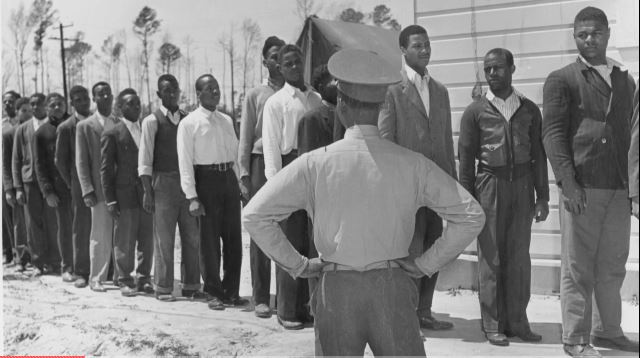Montford Point Marines Established An Undeniable Legacy in the United States Marine Corps

This Black History Month, Wounded Warrior Project salutes hidden figures in the United States military. This installment honors the Montford Point Marines.
"It's a long time coming. … Something you look forward to, wonder if you are going to make to live long enough to see it." – Montford Point Marine and retired Sgt. Ruben McNair to ABC News in 2011 before the Montford Point Marines were honored in June 2012 with the Congressional Gold Medal
“I’ll Take The Marines”
They say it’s good to give people their flowers while they are alive.
In 2012, the 368 remaining Montford Point Marines were finally given their “flowers” in the form of America’s highest civilian honor: the Congressional Gold Medal.
That’s a little more than the famed Thermopylae 300.
As recently as this Black History Month, a Montford Point Marine was honored: 89-year-old Nathaniel Boone was recognized for his valor at the Vermont Supreme Court.
Flash back to the 1940s. There was a higher chance of seeing the president taking a casual stroll in your hometown than seeing a black Marine. These sightings were so rare that in 1943, at home on leave, Pvt. 1st Class R.J. Wood was arrested in Cleveland – wearing the famed Marine dress blues – for impersonating a Marine.
Flash forward to 2017. Many Americans know only of a desegregated United States Marine Corps, but there are still veterans who remember the stifling effects of racism in the armed forces – many who predate 1941’s Executive Order 8802. President Franklin Roosevelt’s order abolished discrimination in all government agencies.
Eight years later, the presidential pen wielded its power when Harry S. Truman signed Executive Order 9981 into effect to desegregate military units, but it took the valor of an exceptional group of black Marines to put equality in America’s crosshairs.
But before their bravery was displayed on a global stage, 21,609 trained to join “the toughest outfit going” in June 1942 in Montford Point, North Carolina. Recruiting offices were overwhelmed with a glut of black men who wanted prove their mettle as patriots.
A group of 1,200 recruits was selected as the first to train in segregated Jacksonville, North Carolina. What could have possibly been a starker reminder of Southern racial division than the steel bars that cut through the land with “colored only/white only” resolution? Railroad tracks divided the town as a physical reminder of the division that clung to the training facilities like the humid summer air.
Just one example of racism the black Marines endured was the requirement to be accompanied by a white Marine to enter Camp Lejeune.
It didn’t take long for Montford Point to overflow with stellar recruits. By 1945 every drill instructor and quite a few non-commissioned officers (NCOs) were black. The outcry for black Marines to train their colleagues was heard: several of the recruits were chosen to become NCO drill instructors.
It is no secret that Marines take tremendous pride in their marksmanship skills; at the time, they owned a litany of anti-aircraft gunnery records. The Montford Point Marines smashed several of them with a weapon nicknamed “Lena” in honor of a famed black actress of that time, Lena Horne.
If not for the talent and bravery of this cadre of trailblazers, the Marine Corps would not have been able to return to its prewar policies.
Always Faithful
With the whole planet plunged into peril, the beginning of World War II heralded a new way for black patriots to fight for their country.
World War II’s Iwo Jima was only one of the places the world got a chance to see at least a little of the exceptional bravery of the Montford Point Marines.
In late 1942, a group of 600 recruits was selected for the 51st and 52nd Composite Defense Battalions, and 1943 was a breakthrough year for Montford Point. In January, Pfc. Edgar Huff became the first black NCO. February saw Gilbert “Hashmark” Johnson become its first drill sergeant. Johnson and Huff quickly gained reputations as two of the toughest leaders at Montford Point.
These promotions heralded significant progress for Montford Point that year: training was done exclusively by black drill instructors and sergeants. Barriers of discrimination were not nearly enough to stop the group from exemplary performance in training.
The 51st had a special reputation that wasn’t to be taken lightly: their gifts earned them renown as some of the Corps’ most accurate artillery gunners. There was no lack of opportunity for engagement for the Montford Point group; it was discrimination that limited their chance to fight for their country.
When they were shipped to the Pacific, much of the 51st and 52nd was stationed on islands well away from the main conflicts. Only a few of these black Marines got the chance to fight: the Ammunition and Depot Companies of Peleliu, Saipan, and Guam. On June 15, 1944 at Saipan, Pvt. Kenneth Tibbs was the first casualty.
In 1998 Staff Sgt. Vernon Harris, a Parris Island drum major, composed the music to “I’ll Take The Marines,” a song that immortalized the Montford Point Marines.
There is one thing all hidden figures have in common: victory and visibility for a few is a triumph for all. According to Harris, the enduring importance of the Montford Point Marines is that they are a symbol for the whole Marine Corps: "If African Americans at that time could go through the rigorous training of Marines when it was segregated and they were looked down on and still be proud Marines … it encourages all Marines to look forward and recognize our progress.”